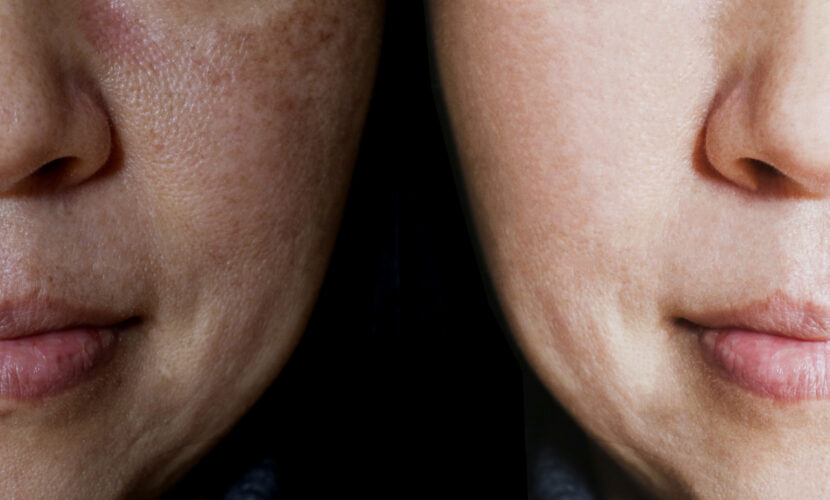Melasma is a skin problem that many women suffer from and for all those who want to maintain beautiful skin, melasma is naturally something to be avoided. If left untreated, melasma appears on both cheeks of the face and greatly affects the appearance of the skin. Here, we will explain in detail what melasma is and the causes of its occurrence. We will also look at the characteristics of people who are prone to developing melasma and those who are less prone to developing melasma, as well as prevention and treatment methods. We hope that the information on prevention and countermeasures for melasma will help you maintain healthy skin.

Graduated from the Faculty of Medicine, National Kumamoto University. After serving as the director of major beauty clinics in Japan, etc., he opened Aladdin Aesthetic Clinic in 2023. He is a professional in aesthetic medicine with a doctorate in anti-aging research and many years of experience. With the motto of "Toward the realization of cosmetic medicine without lies," he aims to be the "Only One" together with his patients.
Basic knowledge of melasma and causes of its occurrence

Melasma is a skin condition usually seen in women in their thirties to fifties, characterized by light brown to gray spots that appear especially on the upper cheekbones and forehead of the face. These spots are caused by an overproduction of melanin pigment in specific areas of the skin and, unlike the usual freckles or senile pigmentation, are more widespread and uniform in color.
Melanogenesis process
Melanin pigment production takes place in melanocytes in the skin. Melanocytes produce melanin through a process called melanogenesis, which determines skin color. Prolonged exposure to ultraviolet light activates melanocytes, causing them to produce more melanin than normal. In melasma, this melanin accumulates locally in certain skin layers and thus appears as spots on the skin surface.
Hormonal effects
Hormonal influences are also believed to play a significant role in the formation of melasma. In particular, studies have shown that the balance of sex hormones such as estrogen and progesterone is involved.
Pregnancy and oral contraceptive pill (pill) use affect the appearance of melasma because these hormones alter the activity of melanocytes. This may accelerate the production of melanin, causing existing spots to darken or new melasma to form.
Genetic and environmental factors
Genetic factors cannot be ignored in the development of melasma. It is believed that individuals with certain genetic backgrounds are more likely to develop melasma because of the different activity of genes involved in melanin production. In addition, lifestyle and environmental factors also play a major role. For example, chronic stress can lead to hormonal imbalance in the body and promote skin pigmentation.
Treatment and prevention of melasma requires a comprehensive understanding of these factors and an approach tailored to the individual living environment and constitution. Routine UV protection, appropriate skin care, a well-balanced diet and stress management are essential for the prevention and management of melasma.
Treatment of melasma and its effects

A variety of approaches exist for the treatment of melasma, and each treatment method has its own benefits and characteristics that should be considered when applying it. Here we will take a closer look at the main treatments used and their effectiveness.
Treatment with oral medication
As an oral drug, tranexamic acid was originally used as a hemostatic agent, but since its effectiveness in inhibiting melanin synthesis was recognized, it has been widely used in the treatment of melasma.
Tranexamic acid prevents excessive melanin accumulation by reducing the inflammatory processes involved in skin pigmentation. When taken, it evens out skin tone and reduces the visual impact of blemishes.
Treatment with topical medications
As a topical treatment, vitamin C derivatives are high in antioxidants and known to inhibit melanin production, vitamin C is used in derivative form to improve penetration into the skin. With regular use, it can be effective in brightening the skin and fading existing pigmented spots.
Hydroquinone is also a very potent whitening ingredient, directly inhibiting the melanocytes' ability to produce melanin. While hydroquinone is particularly effective against stubborn melasma, it is highly irritating and should be used with caution. Its use under the guidance of a medical specialist is recommended, and a rest period after a certain period of use is generally required.
laser therapy
The most well-known treatment for melasma is the Pico laser. Using the latest laser technology, this treatment uses very short pulses to act directly on small pieces of melanin. This effectively breaks down and expels the melanin without damaging the surrounding tissue. The PicoLaser is the treatment of choice for many patients because of its very short downtime after treatment and low skin burden.
Who is prone to melasma? Those who are less likely to develop melasma?

Melasma is a concern for many women, but why does it appear more easily in some and less in others, even in the same environment? Here we will explain some common misconceptions and facts about melasma and take a closer look at the differences between spots, melasma, and freckles, as well as the relationship between stress and pigmentation.
Characteristics of people prone to melasma
A closer look at the factors that predispose to the development of melasma shows that geographic and environmental factors also play a role. People living in areas with particularly strong sunlight are more susceptible to the effects of ultraviolet radiation, which promotes melanin production. Stimulation by ultraviolet rays overactivates melanocytes in the skin, creating a situation in which melasma is more likely to occur.
In addition, people who engage in many outdoor activities are also at increased risk for melasma. People engaged in sports and outdoor work are exposed to ultraviolet radiation for extended periods of time, resulting in cumulative sun damage and noticeable effects on the skin. This is because UV rays directly irritate the skin and promote the formation of spots and melasma by stimulating the activity of pigment cells.
Differences due to skin color should also not be overlooked. In general, people with fair skin have less melanin and a weaker natural defense system, which means that they have less ability to protect their skin from UV rays. For this reason, people with fair skin are more susceptible to the effects of UV rays, which can cause hyperpigmentation.
Characteristics of people who are less likely to develop melasma
The first effective way to prevent melasma is through proper sun protection. The use of sunscreen as well as physical protection measures such as hats and parasols can protect the skin from UV rays and greatly reduce the risk of melasma. In addition, the routine use of UV-protective skin care products is also very effective in maintaining healthy skin.
Next, a well-balanced diet plays an important role in the prevention of melasma. A diet rich in antioxidants can decrease oxidative stress in the body and reduce damage to the skin. Nutrients such as vitamins C and E and beta-carotene are particularly important in supporting skin health. These nutrients revitalize skin cells and contribute to the maintenance of healthy skin.
In addition, stress management is also essential for melasma prevention. Stress can adversely affect hormonal balance and cause skin problems. Proper stress management can help maintain hormonal balance and skin health. Meditation, yoga, and adequate rest can reduce the effects of stress on the skin and improve skin conditions.
Common Misconceptions and Facts about Melasma
Below is a summary of what is commonly misunderstood.
- Do all spots have the same cause?
Melasma is often caused by fluctuations in female hormones and the effects of ultraviolet radiation in particular, and has different characteristics from other types of blemishes. Melasma is also characterized by a tendency to recur. - Can sunscreen prevent melasma?
As mentioned above, sunscreen and UV protection can prevent melasma from worsening. However, melasma is strongly influenced by hormones and may be difficult to prevent completely even if UV countermeasures are perfect. Comprehensive skin care and lifestyle changes are necessary.
Difference between spots, melasma, and freckles
Although spots, melasma, and freckles are all caused by skin pigmentation, they differ in the causes, characteristics, and appearance of their development. Understanding these differences will help you choose the appropriate preventive measures and treatments.
- Blemishes (pigmented spots)
Blemishes are pigmentations of the skin that appear primarily in people after middle age. Damage from ultraviolet radiation is the primary cause, and the direct effects of sun exposure promote the formation of spots. UV light stimulates melanocytes in the skin, causing an overproduction of melanin, which over time accumulates in the skin and appears as small, dark patches. These are generally found on the face, backs of the hands, shoulders, and other areas prone to sun exposure. - Melasma (melasma)
Melasma is a skin problem that is particularly common in women and is a combination of female hormonal fluctuations and ultraviolet radiation. Hormonal changes during pregnancy and with the use of the pill have a significant impact on the formation of melasma. Melasma usually appears symmetrically in the center of the face as large light brown to grayish-brown patches on the cheekbones, forehead, and upper lip. This type of hyperpigmentation has a uniform coloring and well-defined borders. - Freckles (freckles)
Freckles are hyperpigmentation with a very strong genetic component and are mainly seen in children and young adults. Due to a genetic characteristic, melanocytes overreact to ultraviolet light and appear as small brown spots. They are particularly concentrated on the cheeks and nose of the face and are usually more pronounced after sun exposure. Freckles tend to darken with UV light, but may fade with age.
Understanding these differences and choosing the appropriate skin care and treatment for your skin condition is key to maintaining healthy skin. Sun protection, choosing the right skin care products, and maintaining a healthy lifestyle are key to managing these pigmentations.
What is the proper way to prevent melasma?

By taking appropriate preventive measures, the occurrence of melasma can be effectively controlled. This section details specific methods for preventing melasma.
Methods and precautions for self-diagnosis
Self-diagnosis of melasma is an effective means of early recognition of skin abnormalities. Using a mirror, regularly check the facial skin for new spots or color changes. In particular, if there are light brown patches that appear symmetrically in the center of the face, they are most likely to be melasma. However, self-diagnosis is only preliminary and an accurate diagnosis should be made by a specialist.
An accurate diagnosis of melasma is made by a detailed skin examination by a specialist. In addition to a visual examination, specialists at cosmetic clinics and other centers may also perform skin biopsies as needed. This process is essential for the selection of the appropriate treatment and to maximize the effectiveness of the treatment.
Preventive measures that can be taken in daily life
The most important preventive measure for melasma that can be taken in daily life is UV protection. Daily use of sunscreen with a high SPF value and avoidance of direct sunlight are effective in preventing melasma. In addition, the use of hats, sunglasses, and parasols can reduce the direct effects of UV rays.
Points to improve diet and lifestyle
A healthy diet is also important in the prevention of melasma. Consuming foods rich in antioxidants, in particular, can help reduce oxidative stress in the body and minimize damage to the skin. Make it a point to consume fruits, vegetables, and nuts high in vitamins C, E, and beta-carotene on a daily basis.
Effective skin care products and ingredients for prevention
Skin care products that are effective in preventing melasma contain whitening ingredients. Vitamin C derivatives, tranexamic acid, and hydroquinone help inhibit melanin production and reduce pigmentation of existing spots. When choosing products containing these ingredients, it is recommended to consider their gentleness to the skin and, if possible, conduct a patch test before use.
summary
The effects of melasma can be minimized through proper prevention and countermeasures. Incorporating the basic knowledge of melasma, preventive measures, and treatments described here into your daily life can help maintain skin health. It is important to understand the importance of a professional diagnosis and to practice it in conjunction with self-care. Take steps you can take now to achieve brighter, healthier skin.
At Aladdin Aesthetic Clinic, based on our many years of experience in cosmetic medicine and cosmetic dermatology and the knowledge of our doctoral degree, we provide counseling that aims to be "only one", offering the best treatment for each person we meet. We offer only the necessary treatments without any unnecessary information or suggestions.
Feel free to use our official LINE account for 24-hour counseling and reservations. Please feel free to contact us for free counseling for the first time or if you have any concerns.






